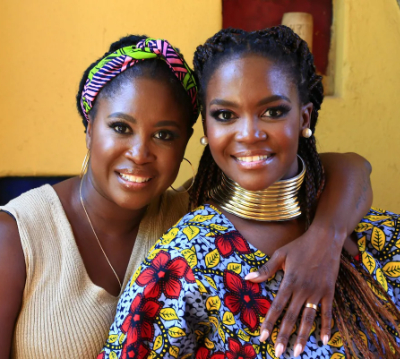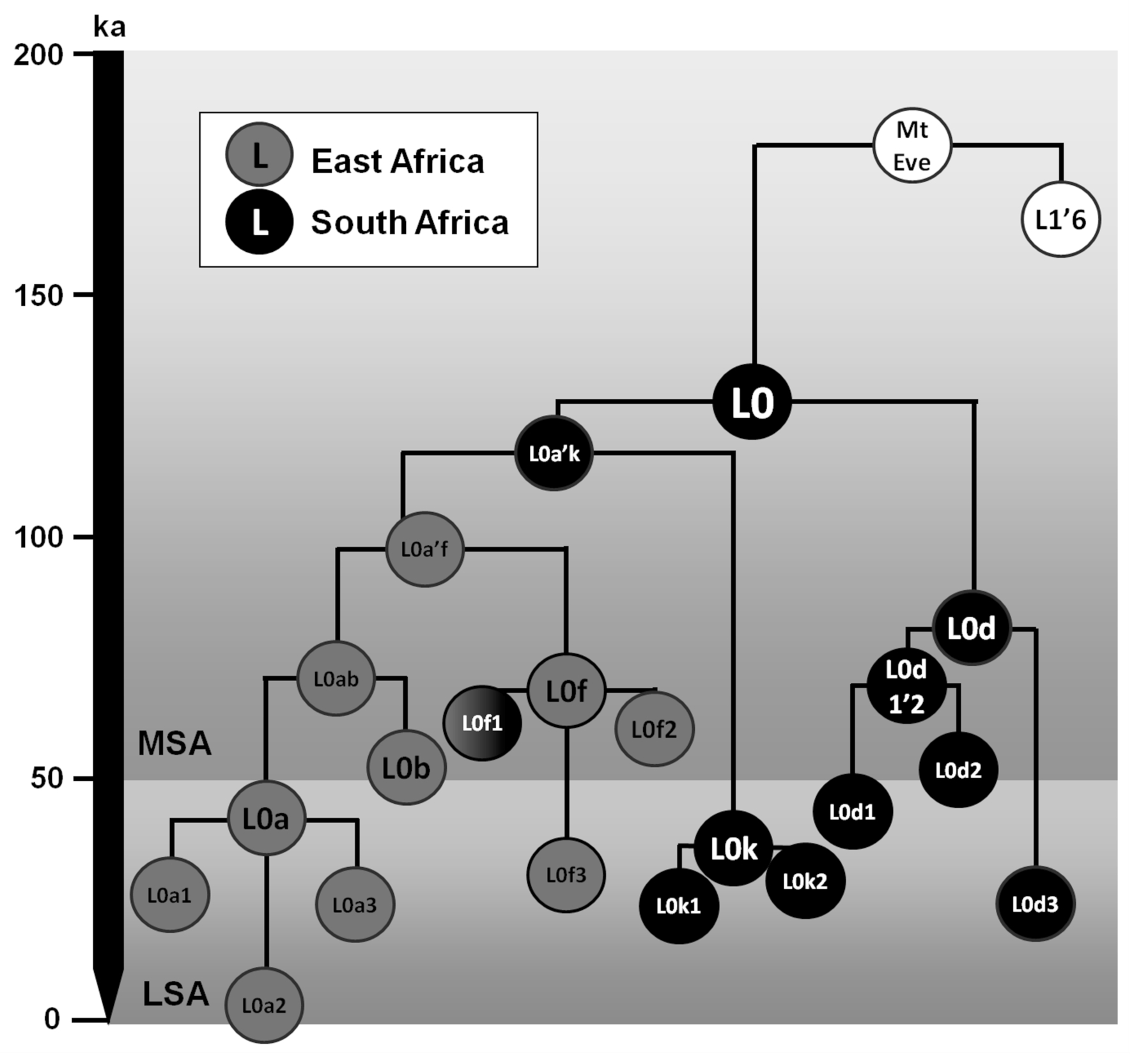Feedback archive → Feedback 2023
Documentary series ‘DNA Journey’ goes to Africa
Sandra H contacted CMI with a question about the out-of-Africa hypothesis, Mitochondrial Eve, and the implications for the way we value all human beings. It concerns two sisters, South African celebrities who took part in a television series called ‘DNA Journey’.1 Andrew Sibley replies:

Oti and Motsi Mabuse were in South Africa recently for this programme tracing the heritage of different TV personalities. They have to use DNA because there are very few written records for a lot of black people in South Africa. They were delighted that they are related to Nelson Mandela and Desmond Tutu. The expert from Edinburgh University eventually pointed out to them that their heritage goes back two hundred thousand years to Eve and eventually he said he had a picture of their ancient ancestor; at this point I was wondering what to expect because of my belief in Creation and that we are indeed related to Eve, but not two hundred thousand years ago. He showed her a picture of a skull, and Oti and Motsi were again delighted. If I remember correctly, we were recently informed by evolutionists that they have called our ape-like ancestor Eve. Could they really be saying this? He had shown them a chart showing that their heritage goes back further than his own. [Surely] I can’t be the only person to realise what he was really saying?
I would love to have told Oti and Motsi that we all go back to Adam and Eve, that we are all special and God created us. I am wondering if they really understood what this man was saying, basically that they were lower down the evolutionary tree than he was.
Did anyone at Creation watch this programme? and what were their thoughts?
Sandra H
Thanks for the question, Sandra. The programme was first shown on television in the UK in March 2023,1 and I have now watched it on Youtube.2 For the benefit of other readers, the programme takes two very charming celebrity professional dancers, sisters Oti and Motsi Mabuse, back to South Africa in order to search for their family history and connections.3 They find some of their relatives, and discover they are connected to royalty (in terms of the Kekana nobility in Hammanskraala) via a tribal princess—and also to the late President Nelson Mandela (1918–2013) and the Archbishop Desmond Tutu (1931–2021).
Towards the end of the programme they meet with Professor Jim Wilson, a human geneticist from Edinburgh University. He informs the sisters about their mitochondrial DNA (mtDNA), and suggests it links them via the maternal line to humanity’s most recent common ancestor (MRCA), who is colloquially called Mitochondrial Eve and said to have lived 200,000 years ago. Professor Wilson stressed it was not the biblical Eve. For biblical creationists, the idea of a female MRCA is consistent with the account of Adam and Eve, although we recognise that, from a scientific perspective, there is no logical requirement that there was only one female alive at the time. But from the Bible, everyone on earth is a descendant from that same common ancestor, Eve. However, at the Flood cataclysm the human population was reduced to Noah’s immediate family of eight.

It was found that the sisters have the rare L0d (L0d2a) haplogroup, which is connected to the San people of South Africa. Wilson also showed them a skull of a boy, the Ballito Bay child, who lived 2000 years ago as part of a hunter-gatherer community, and had the same haplogroup. This boy’s DNA has been sequenced, and some scientists believe it extends the time of the split between modern humans and earlier human groups to around 300,000 years ago (350,000–260,000 years ago),4 although Jim Wilson didn’t make this case in the programme.
According to secular scientists, modern man first evolved in southern Africa, and then spread to the rest of the world. Many people mistakenly believe the mtDNA found among these southern African people are the most ancient lineages. In reality, all mitochondrial lines are the same age, but some branch off ‘earlier’ than others. Thus, in the evolutionary world, some people are said to carry mtDNA from one of the earlier splits and some from latter splits, but this does not make their line ‘older’ than the other lines.
CMI’s Carl Wieland noted many years ago that the rate of mutation of mtDNA is variable, and in some academic papers, as high as one mutation in 40 generations, compared with the previous claim for just one mutation in 600 generations (see A shrinking date for ‘Eve’).5 On the female line, this reduces the time back to the most recent common ancestor to around 6000 years. Following criticism from naturalistic scientists, this was well defended by Wieland in 2006. Yet, those conclusions were based on very limited data. More recent work has turned up many more mitochondrial mutations and has shown that the mutation rate is much faster than ‘one in 40 generations’. In fact, it could easily be as high as one mutation every other generation.6 Also, there is no reason to expect the mutation clock to always tick at the same rate. There are multiple ways to speed up the clock, for example, and we would directly expect this to have happened right after the Flood.7
Is the out-of-Africa evolutionary hypothesis racist?
As for an inherent racism in the claim of secular science, there is indeed a legacy of racism in the doctrine of evolution, with competing teams of evolutionary scientists looking for the most ancient hominid remains in Africa; for example, the find of Homo naledi in 2013 in South Africa. Such racist evolutionary speculations were initially occasioned by the observation that many people of African descent had prominent facial features and dark skin, ideas that linger today. Darwin wrote that:
“It is therefore probable that Africa was formerly inhabited by extinct apes closely allied to the gorilla and chimpanzee; and as these two species are now man’s nearest allies, it is somewhat more probable that our early progenitors lived on the African continent than elsewhere.”8
Thomas Huxley, a close associate and defender of Darwin’s work, commented as follows:
“… if we place A, the European brain, B, the Bosjesman brain [San people of southern Africa], and C, the orang [orangutan] brain, in a series, the differences between A and B, so far as they have been ascertained, are of the same nature as the chief of those between B and C.”9
An evolutionary origin of man in Asia has also been proposed because of increasing problems with the ‘Out of Africa’ theory.10 However, all such ideas, from Darwin to the present day, are racist and they denigrate the image of God in human beings. Historian A.N. Wilson has written a book (2017) in response to the foundation and influence of evolution (reviewed here11) and he commented in his blog:
“It will be interesting to see how long it is before someone reads Charles Darwin’s Descent of Man and decides that his statue should be removed from the Natural History Museum. He was not merely, like so many Victorians, profoundly racist. He it was, especially in that disgusting book [The Descent of Man, and Selection in Relation to Sex, 1871], who tried to give racism a ‘scientific’ justification.”12
Summary
Although Professor Jim Wilson (in DNA Journey) said that Mitochondrial Eve is not the same as the biblical Eve, the scientific evidence for the possibility of faster mutation rates, as outlined by Wieland, demonstrates that it is consistent with the biblical account of the recent creation of Adam and Eve.
Belief in evolution has in the past been influenced by racist thinking, and has also given justification to it at a foundational level. Darwin and Huxley both made statements that modern society would consider to be highly derogatory to African people. We note that many modern geneticists who accept evolution are not necessarily racist in their own beliefs, but we certainly question the dreadful heritage of evolutionary thinking.
Regards,
Andrew Sibley
References and notes
- Series 5, part 4 of: ITV, DNA Journey, Voltage TV/Mitre Productions, ITV.com, screened on 28 March 2023. Return to text.
- DNA Journey (Oti and Motsi), youtube.com/playlist?list=PLUBbFCvgQ5Vte1aZLlaVoPMxNDzVYdqoK, 29 March 2023; accessed 15 April 2023. Return to text.
- Motsi is a judge on the BBC’s ‘Strictly Come Dancing’ show in the UK, while Oti was a professional dancer on the same show (known as Dancing with the Stars in the USA). Return to text.
- Schlebusch, C.M. et al, Southern African ancient genomes estimate modern human divergence to 350,000 to 260,000 years ago, Science 358(6363):652–655, 2017. Return to text.
- Wieland, C., A shrinking date for ‘Eve’, J. Creation 12(1):1–3, April 1998. Return to text.
- Madrigal L. et al. High mitochondrial mutation rates estimated from deep-rooting Costa Rican pedigrees, Am. J. Phys. Anthropology 148:327–333, 2012. Return to text.
- Carter, R.W., Patriarchal drive in the early post-Flood population, J. Creation 33(1):110–118, 2019. Return to text.
- Darwin, C., The Descent of Man, 2nd ed., John Murray, London, pp. 155–156, 1890. Return to text.
- Huxley, T.H., On the zoological relations of Man with the Lower Animals, Natural History Review 1:67–84, 1861. Return to text.
- Barras, C., Ancient skull from China may rewrite our origins, New Scientist 236(3152):9, 18 November 2017. Return to text.
- Bergman J., Deconstructing Darwinism—a theory gone bad, a world gone mad, a review of: Charles Darwin: Victorian Mythmaker, by A.N. Wilson, J. Creation 32(3):25–30, December 2018. Return to text.
- Wilson, A.N., Must Darwin fall? theoldie.co.uk, 22 June 2020. Return to text.






Readers’ comments
Comments are automatically closed 14 days after publication.